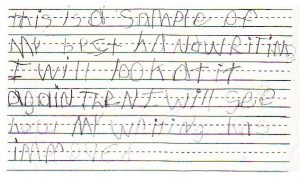Helpful Hints: How to help your child write
As an elementary parent or teacher, have you ever had any concern with your own child or a certain student regarding messy and illegible hand writing? You probably thought that the child is being lazy or it’s just who he/she is. Studies show that people with messy handwriting are smart. In my experience as a teacher, I have observed several students that would prove the study. However, in some cases there are exceptions. You have probably heard the word dyslexia, which is a reading disorder but with writing there is the word dysgraphia. Dysgraphia is a deficiency in the ability to write not due to intellectual impairment. The term comes from the Greek words dys (“difficulty”) and graphia (“writing”).
The Following are some symptoms of dysgraphia:
1. A mixture of upper case/lower case letters
2. Irregular letter sizes and shapes
3. Unfinished letters
4. Struggle to communicate ideas into writing
5. Odd writing grip
6. Many spelling mistakes (Sometimes)
7. Misses letters to complete a whole word when copying
8. Decreased or increased speed of writing and copying
9. Talks to self while writing
10. Writing is not legible
11. Reluctance or refusal to complete writing tasks
12. Experiencing physical pain in the hand and/or arm when writing
13. Poor use of lines and spaces

(an example of dysgraphia)
A study shows that there is no exact “cure” for this handwriting problem, but at a young age early intervention is advised. The following tips are observed to be helpful by experienced teachers and parents that pushed their child to bring out their best in writing.
- – Use fat pencils for proper gripping
- – Teach the child writing warm-up exercises to ready his/her hands in writing.
- – Play games that strengthen motor skills.
- – Make sure that the child writes while sitting at a table rather than lying on his/her bed.
- – Give the child plenty of time to write and have some breaks to rest her/his hand.

